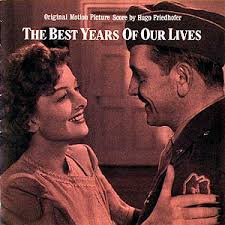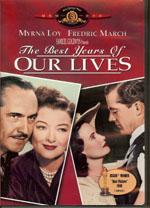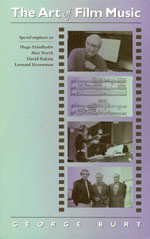Film in Focus No. 1:

THE BEST YEARS OF OUR LIVES
and
Hugo Friedhofer's film score
Searingly poignant and joyously tender, William Wyler’s production of THE BEST YEARS OF OUR LIVES remains a soaring testament to the sacrifice and heroism of “the greatest generation,” returning home to the uneasy reality they’d fought to preserve and protect.
The country was at once grateful, and unforgiving in their welcoming of the troops who had given up their lives and dreams to fight on foreign shores. While none of the returning American soldiers had asked for thanks or for special treatment, there was a growing and lingering resentment among some who had stayed at home, embarassed by the privileges they’d continued to enjoy, while vicariously sharing a victory won by the blood and emotional scarring of others. Boys had grown to men on foreign soil. Now they returned to their own country as strangers in a strange land, gladiators humbled by the pain of readjustment to an often indifferent, mundane, and trivial existence.
The idea for Wyler’s often sensitive, frequently painful examination of disruption and eventual repair, came from a Time Magazine pictorial article (August 7, 1944), addressing the difficulties of returning American soldiers readjusting to normal life and experience. Author MacKinlay Kantor was so moved by the Time portrayal that he turned the stories into a novel called Glory For Me. Producer Samuel Goldwyn purchased the novel, and commissioned Pulitzer Prize winning screenwriter Robert E. Sherwood to translate the book into visual expression. The film, re-titled THE BEST YEARS OF OUR LIVES, starred Dana Andrews as a valiant gladiator, tortured by memories of battle, returning to a world in which his identity and persona were defined by a demeaning earlier position as a “soda jerk” at a pharmacy in his small home town. Now, matured beyond his years, dissatisfaction with his previous life experience seemed, to many, pompous and pretentious. Fredric March was also featured as a former bank executive coming home to his loyal wife, Myrna Loy, and precocious young daughter, Peggy, played by the lovely Teresa Wright. The scene in which March returns to his apartment and family is as memorable as any in screen history. As he opens the door, he quiets the excited reactions by his daughter and son, wanting to surprise his wife who is washing dishes alone in the kitchen. As she calls out to her children in the other room “Who is it?,” her query is met with silence. She calls again…and then stops in mid sentence. She intuitively reacts to an instinctual recognition of the quiet emanating from beyond the door, and gasps aloud. Turning slowly from the kitchen, she faces her husband, returned from the war. Their silent embrace speaks loudly, and in heartbreaking volume, of the pain of separation and reunion.
The cast is rounded out by first time screen actor, and real life embattled war amputee, Harold Russell, Cathy O’Donnell as the sweet and innocent love (Wilma) he left behind, and Hoagy Carmichael. Among the most sensitive performances is, however, by character actor Roman Bohnen as Dana Andrews’ father, whose tears of pride overwhelm the screen with gentle, understated beauty, as he attempts to read aloud his son’s commendation for wartime bravery to his wife at their squalid kitchen table. His simple reading of the military citation, while fighting back tears, is a powerful, understated gem of screen performance, under the direction of Willam Wyler and cinematographer Greg Toland.
Perhaps the most compelling component of Wyler’s film, however, is its majestic musical scoring by Hugo Friedhofer. Arriving in Hollywood in 1929, Hugo Friedhofer quickly established himself as one of the screen’s most able and popular orchestrators, working closely with such composers as Erich Wolfgang Korngold and Max Steiner on some fifty motion pictures. In 1938, he composed his first full original score for Samuel Goldwyn’s production of THE ADVENTURES OF MARCO POLO. He continued orchestrating scores for other composers. However, as his own reputation as a composer gained increasing stature, his availability as an orchestrator understandably decreased. In 1946, thanks to the enthusiastic intervention of Alfred Newman, Friedhofer was assigned the task of creating a score for THE BEST YEARS OF OUR LIVES.
From the first notes of music illuminating the main title sequence, one is struck by the rapturous eloquence of the score. It is pure Americana, a proud and majestic salutation filling the horizon with hope and promise for a glorious future. This was a new country, a new America reborn from the scarring and smoldering ashes of war, a land of unbridled optimism consumed by the joy of victory, and the limitless promise of tomorrow. The air was fresh and clean once more, and imaginations soared above the clouds. Freed from the bondage of war and depravity, a nearly childlike wonder and innocence permeated America. There was virtually nothing that we couldn’t achieve or become, now that the chains of ideological slavery had been excised.
Friedhofer’s score gently caresses the healing emotional wounds of Wyler’s troubled veterans. Particularly tender, both visually and musically, is the nearly heartbreaking scene in which Homer invites Wilma to witness the utter helplessness he experiences when undressing for the night, laying his hooks on the chair by his bed. The remnants of what had once been his arms and hands, reduced by explosions to ineffectual stumps, leaves him exposed, ashamed, and as vulnerable as a small child, seeking comfort and protection from his mother, in the terrified night.
The score explodes with rage as Fred Derry (Dana Andrews) revisits the corpse of a once noble aircraft awaiting demolition in the scrap yards. Sitting in the ghostly cockpit, the pain of battle returns in searing waves and nightmares, as phantoms of fallen comrades invade his recollections, and Derry remembers the horrific intensity of smoke, screaming comrades and machine gun fire poisoning the clouds around him. Regaining his composure, Derry leaves the skeletal remains of the fallen eagle, and his past, behind him as he is offered a job and, at last, a degree of personal cleansing and redemption.
As Homer finds love and compassion in the arms of his childhood sweetheart, marriage vows bring sanity once more to the children of catastrophe. Fred and Peggy embrace a similarly uncertain, yet loving future together, as Friedhofer’s music reaches glorious crescendo, while both America and her people prepare to rebuild the best years of their lives.
--Steve Vertlieb, 2007
CD Review
.jpg)
This review was written for the Label "X" CD release in 2000. It is reprinted here with slight revisions.
.jpg)
THE BEST YEARS OF OUR LIVES (1946)
Music score by Hugo Friedhofer
11 tracks (Playing Time = 46:11)
Album produced by John Steven Lasher. Performed by The London Philharmonic Orchestra, Franco Collura, conductor. Bob Burns, alto sax. Analogue Recording Engineer: Bob Auger. Digital Remix & Mastering Engineer: Louise Taylor. CD Notes by Royal S. Brown and Page Cook. Recorded at Church of All Saints, Tooting, London, 21-23 October 1978. . Released by Film Continent Music Classics in 2000.
Cinema Maestro/ Label "X" CD 14, 2000
Rating: ****
With such wide acclaim, I thought it would be appropriate to review this CD from Australia of the soundtrack first released on the Preamble label in 1988. It was re-issued in 2000 on Label "X."
I was fortunate enough to acquire the original release of THE BEST YEARS OF OUR LIVES when it was released in 1978 on an Entr'acte LP. This was listed as "A Composer Authorized Recording," so Hugo Friedhofer obviously approved of its release. Orchestrator for this recording was Tony Bremner. The LP had a deluxe eight page booklet with a score analysis by Louis Applebaum, notes by Royal S. Brown and Page Cook and photos of Friedhofer and from the film. There was also a special 7" record containing one side one a 50th Anniversary Tribute to Friedhofer, written by Gene Lees and spoken by Richard Hatch; and on the other side, "The Homecoming," a key scene from the film complete with dialogue and music. This special LP release is now a collector's item -- it remains one of my fondest film music trasures.
The Label X CD has the same tracks, with digital mastering of the analog LP. But unfortunately, the extra tribute to Friedhofer is not included on the CD.
THE BEST YEARS OF OUR LIVES featured Myrna Loy, Fredric March (Oscar winner), Dana Andrews, Virginia Mayo, Teresa Wright and Harold Russell (who won two Oscars). The screenplay was written by the gifted Robert E. Sherwood. Director of photography was Gregg Toland, who worked with Orson Welles on CITIZEN KANE. The film was directed by William Wyler. Hugo Friedhofer also won an Oscar for Best Score of 1946. Altogether, the film received eight Oscars.
The Main Title (1:25) is one of the most memorable of any film score every written. It is poignant and powerful at the same time. The next track, "The Homecoming" (6:17), has some of the most heartwarming music every composed for a film, accompanying the three servicemen returning home after the war. But not all of the score has that same poignancy. There is Fred's (Dana Andrews) frightening remembrance of his bombardier duty on track 5, "The Nightmare" (6:12). This cue starts very softly and offers a hint of the song, "Among My Souvenirs" (the favorite of husband and wife characters played by Loy and March). Then it builds to a terrifying climax as Fred remembers his buddy lost in a bombing raid over Germany. This is one of the highpoints from this magnificent score. Another highlight occurs on track 9 ("The Citation/ Graveyard and Bombers" - 4:21), with the glorious main theme coming back and leading into the menacing graveyard scene for bomber planes.
Actually all the tracks from this score have something worthwhile to hear. The digital mastering is beautifully done and the sound is crisp and clean.
The CD doesn't have the score analysis by Louis Applebaum as with the LP notes, but does have the original extensive track by track notes by Royal S. Brown and a glowing appreciation of Friedhofer by Page Cook.
The last page has a note from producer John Steven Lasher. He admits to having problems with the close-miking of the original LP "which tended to favour certain instruments (the harp, celeste, piano, xylophone and timpani) in the recording." After nineteen years, Lasher decided to correct the recording with digital mastering technology. He concludes: " the end result is such that many will believe they are listening to a completely new recording. Of course, you - the listener - must be the final judge."
I believe this is what Friedhofer's milestone score has deserved and now received.
If you've never heard this score, you owe it to yourself to get this wonderful CD.
It belongs in every serious film music collector's library.
--Roger Hall, 10 July 2001
Comments regarding this Film Focus article and review may be sent to:
Film Music Review
See also the CD review for
WOMAN OBSESSED (1959) and IN LOVE AND WAR (1958)
DVD and Book

DVD: THE BEST YEARS OF OUR LIVES
Recommended Book...

The Art of Film Music
by George Burt
Northeastern University Press, 1994
Detailed description with score examples of
THE BEST YEARS OF OUR LIVES, pages 143-168.
100 Essential Film Scores
.jpg)
THE BEST YEARS OF OUR LIVES is listed in the Top 10 of the
100 Essential Film Scores of the 20th Century

Film Music Review (Home Page)
